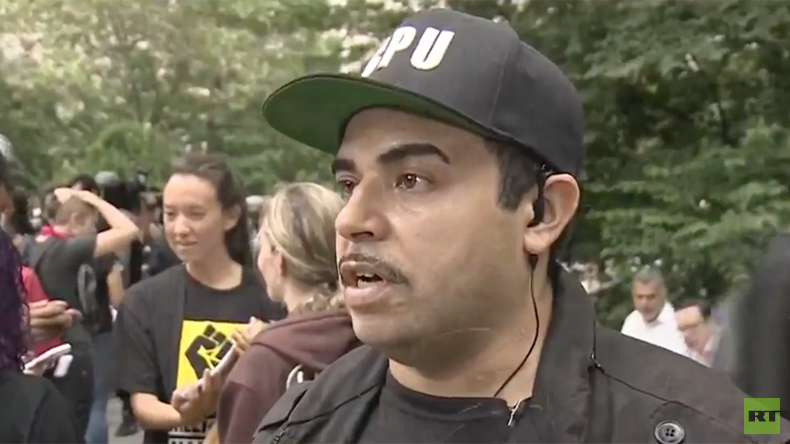Prominent 'copwatcher' accuses NYPD of targeted, unconstitutional arrests

The NYPD is no stranger to prominent “copwatcher” Jose LaSalle. And between word on the street, profile pieces, lawsuits, and many media appearances, neither is LaSalle a stranger to them. Now he’s accusing the department of targeting him with unconstitutional arrests.
LaSalle was copwatching outside the Patterson Houses, a public housing complex in The Bronx managed by the New York City Housing Authority on the night of August 5. Copwatching is a practice by which activists follow police around with cameras in order to document their interactions with communities.
The events of the night of the fifth and the sixth were highlighted by LaSalle at a press conference outside the NYPD’s main headquarters Tuesday morning, and were discussed in further detail with RT.
[AMENDED] MEDIA ADVISORY for 8/16 @ 10AM, 1PP. Emergency rally: #JoseLaSalle of @CopwatchCPU Unlawfully Arrested. pic.twitter.com/KCw5xBaLBo
— Millions March NYC (@MillionsMarch) August 16, 2016
Near the Patterson Houses, LaSalle encountered a stop-and-frisk and began documenting. Afterwards, LaSalle was arrested and escorted to Police Service Area 7 (PSA 7), a housing precinct in The Bronx by an “unmarked unit,” LaSalle told RT.
While it is legal to film the police in the United States, getting too close to or otherwise interfering with police work can lead to charges of Obstruction of Government Administration.
The Office of the Deputy Commissioner, Public Information would not comment to RT on what actions LaSalle took to lead officers to establish probable cause for his arrest.
“Officers know who I am. There was one officer sitting outside and he said ‘Hey! Mr. LaSalle, how are you doing?’” LaSalle said. “There were only six or seven officers inside, but within seconds, there were 30 officers there. They all came to see me getting locked up.”
Officers then began to search through LaSalle’s belongings.
“They pulled out my two-way radio, we use that as walkie-talkies to communicate with other copwatchers while we’re out on patrol,” LaSalle says, adding that the desk sergeant then said it “looked like a scanner” that “transmits.”
It is legal to own a police scanner in New York City, however having one that ‘transmits’ onto police frequencies is illegal.
LaSalle adds that an officer present said, “we got you, we got you for a felony,” followed by officers clapping. LaSalle says his arresting officers were then congratulated for “getting this guy.”
“It was like they were throwing a party there over my felony arrest. And all that was recorded on audio on my phone.”
#ShutDownCityHallNYC protesters speak out against police brutality pic.twitter.com/VcG9C6Ye4B
— RT America (@RT_America) August 1, 2016
“He was charged with disorderly conduct, unlawful possession of a radio device and criminal use of an access device,” and “He was subsequently found to be in possession of a two-way radio capable of receiving and transmitting on a department frequency. A radio check was conducted which confirmed that the radio possessed had the capability to communicate unauthorized transmissions,” the Office of the Deputy Commissioner, Public Information, told RT.
The next morning, LaSalle was taken to booking and says he was there from roughly 6:00am to 8:00pm. At that point, LaSalle says he was called from his cell and handcuffed by an officer, who led him through several doors as LaSalle asked a few times where he was being taken to and for what purpose - to no avail.
He was then taken outside and had his handcuffs taken off. LaSalle says he was released without any paperwork or a Desk Appearance Ticket (DAT). The Office of the Deputy Commissioner, Public Information would not comment as to whether the initial release came with a DAT or not.
“So I sat there for like a minute, trying to think what’s going on. If I step out of here am I going to be charged for escape? Usually you go through the Deputy Inspector of Security,” who asks your name, date of birth, address and other information.
LaSalle then returned to PSA 7 to retrieve his property, which was granted to him.
“Then I went to meet up with my comrades doing jail support waiting to see what happened to me. We went to a diner and I ordered a burger. I shared with them that I had this audio recording of the officers clapping. Some of them got on Twitter, social media, and blasted it out. On Twitter, the pictures they sent out had the name of the restaurant we were at. Officers came into the restaurant asking ‘Mr. LaSalle, could we have a word with you?’” LaSalle told RT. “An hour after I was released, an hour after the felony charges for supposedly a scanner that transmits was dropped, police officers appeared there, plain clothes officers.”
LaSalle said an officer said they were arresting him, because he wasn’t given a court date while in booking and that they wanted to make sure he wouldn’t be issued a warrant for not coming to court. LaSalle disputes that assertion.
In a video recording, an officer can be seen on the phone seeking directions and then telling another officer that they need his personal effects. The officer, on the phone again, says “so the phone we’re going to need.”
The Office of the Deputy Commissioner, Public Information, would not comment on whether LaSalle’s cellphones were wanted as a part of any investigations or whether the phones were within their possession, as LaSalle says.
LaSalle suspects that the officers were trying to obtain “damning evidence” of their actions the night prior, particularly the alleged celebration of his felony charges by NYPD officers.
“While I’m in the precinct, they didn’t put me in the cell. While I’m there being cuffed, somebody tried to get into my phone. I have a program called Lock Watch. What that program does, when anybody puts in a code and hits ‘enter,’ it takes a picture, a 10-second audio clip, and gives you a GPS location of the person trying to get into my phone. That was done twice by the police.”
“An officer came and asked me for my password. I said ‘anything you want to ask me, ask me in front of my lawyer,” LaSalle told RT.
LaSalle said he was then moved back to booking. He says he asked his arresting officers what his charges were and was told that they didn’t know. That time, LaSalle said, he was issued a DAT with a return date but no charges.
“I went back to the precinct to ask for my property, which they never gave me a voucher for. They gave me my keys, my hat, my wallet, and I said I need my phone,” LaSalle reported.
The commanding officer informed LaSalle that they would be holding the phone on the advice of NYPD lawyers and the District Attorney.
“I said, ‘hold the phone for what? What am I being charged with.’” LaSalle recalled saying.
He then asked for paperwork detailing the property of his in their possession.
“The first paperwork they did, they came back, it only had my GoPro and my LG Camera.”
LaSalle told RT that he then demanded they put his phones into the paperwork and that officers said he was “giving them a hard time,” but eventually put his phones into the paperwork.
LaSalle added that the district attorney’s office is now investigating why the precinct held onto his phone and says that they are attempting to cover up the attempted break-in documented by his Lock Watch App.
“So now, it’s a whole big thing. ADA (Assistant to District Attorney) has no idea what’s going on. They’re investigating themselves, and don’t know why I was released. My lawyer told them, ‘if there was a mistake with you releasing him, you will have to answer that. Maybe if you make a mistake with someone like LaSalle, maybe one day in the future you’ll make a mistake and let a convicted murderer go.’ So, they said they’re going to investigate it,” LaSalle said.
“I gave a statement to the Internal Affairs Bureau. I gave a statement to the Civilian Complaint Review Board. I also filed a complaint with the NYPD Inspector General,” LaSalle said.
LaSalle began his copwatching career in 2011, after his stepson, Alvin, became a victim of a stop-and-frisk in New York City, on the grounds that he looked “suspicious.”
Alvin recorded audio of the interaction, which sparked a fiery debate in mainstream media over the city’s stop-and-frisk policy. But in the year it took for the recording to hit the press, LaSalle’s wife, Alvin’s mother, passed away, and LaSalle committed to the practice of what he calls “policing the police,” wherein he maps the location of police interactions and forms a route, with the help of a data tool not operationally dissimilar to the NYPD’s infamous predictive policing tool CompStat.
“Surely, they came into that diner because they knew what I had on that phone was going to be very negative towards them, because for them to be screaming that we wanted him and we got him … it just goes to show that I have become enemy number one of the NYPD. You could see their focus was the phone. You could see when they got the phone, they cuffed me and we went. So why would they be targeting the phone? It’s because they were eavesdropping and saw what we were talking about on our social media,” LaSalle said.
“It’s sad because I know that they are out there waiting for me to slip up, so they could get me. They want to railroad me and find a way to do it,” he told RT.
by Alexander Rubinstein











